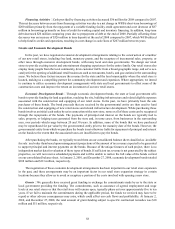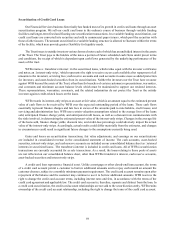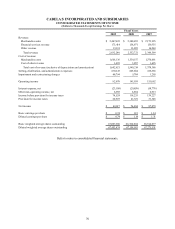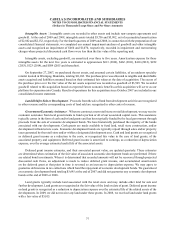Cabela's 2009 Annual Report Download - page 76
Download and view the complete annual report
Please find page 76 of the 2009 Cabela's annual report below. You can navigate through the pages in the report by either clicking on the pages listed below, or by using the keyword search tool below to find specific information within the annual report.
67
ITEM 7A. QUANTITATIVE AND QUALITATIVE DISCLOSURES ABOUT MARKET RISK
We are exposed to interest rate risk through our bank’s operations and, to a lesser extent, through our merchandising
operations. We also are exposed to foreign currency risk through our merchandising operations.
Financial Services Interest Rate Risk
Interest rate risk refers to changes in earnings or the net present value of assets and off-balance sheet positions,
less liabilities (termed “economic value of equity”) due to interest rate changes. To the extent that interest income
collected on managed credit card loans and interest expense do not respond equally to changes in interest rates, or
that rates do not change uniformly, securitization earnings and economic value of equity could be affected. Our net
interest income on managed credit card loans is affected primarily by changes in short term interest rate indices such
as LIBOR. At the end of 2008, the variable rate credit card loans were indexed to the prime rate. To mitigate our
interest rate risk, beginning January 2009, the variable rate credit loans were indexed to one month LIBOR and the
credit card portfolio was segmented into risk-based pricing tiers each with a different interest margin. Securitization
notes are indexed to LIBOR-based rates of interest and are periodically repriced. Certificates of deposit are priced
at the current prevailing market rate at the time of issuance. We manage and mitigate our interest rate sensitivity
through several techniques, but primarily by indexing the customer rates to the same index as our cost of funds.
Additional techniques we use include managing the maturity, repricing, and distribution of assets and liabilities by
issuing fixed rate securitization notes and entering into interest rate swaps.
The table below shows the mix of our managed credit card account balances at the years ended:
2009 2008 2007
As a percentage of total balances outstanding:
Balances carrying an interest rate based upon various
interest rate indices 65.2%66.1%61.1%
Balances carrying an interest rate of 9.99% 2.5 1.9 3.1
Balances carrying an interest rate of 0.00% 0.6 1.3 0.3
Balances not carrying interest because their previous
month’s balance was paid in full 31.7 30.7 35.5
100.0%100.0%100.0%
Charges on the credit cards issued by our Financial Services segment were priced at a margin over various defined
lending rates, subject to certain interest rate floors. No interest is charged if the account is paid in full within 24 days of the
billing cycle, which represented 31.7% of total balances outstanding at December 31, 2009. Some of the zero percentage
promotion expenses are passed through to the merchandise vendors for each specific promotion offered.
Management has performed several interest rate risk analyses to measure the effects of the timing of the repricing
of our interest sensitive assets and liabilities. Based on these analyses, we believe that an immediate increase of 50 basis
points, or 0.5%, in the London Interbank Offered Rate on interest charged to customers and on our cost of funds, would
cause a pre-tax decrease to earnings of $1 million for our Financial Services segment over the next twelve months.
Merchandising Business Interest Rate Risk
The interest payable on our line of credit is based on variable interest rates and therefore affected by changes in
market interest rates. If interest rates on existing variable rate debt increased 1.0%, our interest expense and results from
operations and cash flows would not be materially affected.
Foreign Currency Risk
We purchase a significant amount of inventory from vendors outside of the United States in transactions that are
primarily U. S. dollar transactions. A small percentage of our international purchase transactions are in currencies other
than the U. S. dollar. Any currency risks related to these transactions are immaterial to us. A decline in the relative value
of the U. S. dollar to other foreign currencies could, however, lead to increased merchandise costs. For our retail store in
Canada, we intend to fund all transactions in Canadian dollars and utilize our unsecured revolving credit agreement of $15
million CAD to fund such operations.
























